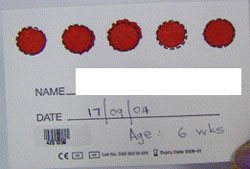
Subscribe & Follow
Advertise your job vacancies
Major boost for early detection of HIV in infants
Innovative Dry Blood Sample (DBS) technology enables state-of-art testing from a simple heel or finger prick for early diagnosis of HIV infection in infants.

Example of dried blood spot collection technology.
HIV positive mothers can test their newborn infants as early as 6 weeks of age with the latest Roche real-time PCR technology. Early confirmation of HIV in infants at six weeks has the potential to reduce infant mortality from HIV infection in resource limited environments.
“By ensuring immediate introduction into special care programs and antiretroviral and antibiotic programs for infants, the progression to AIDS and increased mortality risk can be reduced substantially,” says Knut Seifert, Senior Vice President International Public Health Organizations of Roche.
Dry Blood Spot (DBS) technology for the collection of blood specimens for early infant diagnosis customised by Roche can expand access to HIV diagnosis in infants in resource poor settings by acting as a “point of care” solution. “This solution offers a major break-through in that only small quantities of blood obtained through a simple heel or finger prick are needed. These are collected on a specially designed filter paper which can be stored and transported at room temperature. This procedure can be performed by significantly less skilled staff than required by standard liquid blood collection, which requires highly trained personnel, sterile equipment, cold chain transport and a centralised laboratory. In clinical evaluations, DBS samples stored up to four months yielded reliable results for HIV-1 detection in the laboratory,” says Knut Seifert, Senior Vice President International Public Health Organizations of Roche.
An estimated 1 million new births occur in South Africa every year. Based on HIV prevalence data, this translates into a potential 300,000 HIV exposed infants requiring an HIV diagnosis annually. HIV can be transmitted by a HIV-positive mother to the foetus in the womb or during child birth. Postnatal, prolonged breast-feeding also increases further transmission with a cumulative risk of 30-40%1 .Antiretroviral therapy for HIV positive mothers during labour and post exposure prophylaxis (PEP) after birth cannot guarantee the prevention of transmission of HIV. In the past, it was necessary to wait 12-18 months for maternal HIV antibodies to be eliminated from a baby's system before he or she could be accurately diagnosed with the ELISA test or other methods and treated.
According to Seifert, fast and reliable diagnosis - including for the millions of HIV/AIDS patients in sub-Saharan Africa - is critical to the success of any subsequent therapy. Because they are particularly vulnerable to the disease, it is crucial to know whether or not children have been exposed to HIV/AIDS as soon as possible so that treatment may be started.
By extension, the early identification of HIV negative infants, can equally saves costs as this will prevent the unnecessary prescription of antibiotic prophylaxis and also minimise the stress for parents.
The procedure currently utilized in laboratories to test for HIV-1 DNA combines manual and automated steps requiring time consuming and complex multiple interventions by the user. Roche is the only healthcare company to launch a fully automated HIV-1 Qualitative test utilising the COBAS® Ampliprep Instrument and COBAS® TaqMan® 48 Analyzer. This advanced automation system reduces the hands on time and requires less technically trained personnel, especially relevant in resource poor settings.
For further information please contact:
Jane Erhart from Roche Diagnostics sub-Saharan Africa
Tel: 011 504 4600
Cell: 082 893 8450
Email:
Editorial contact







